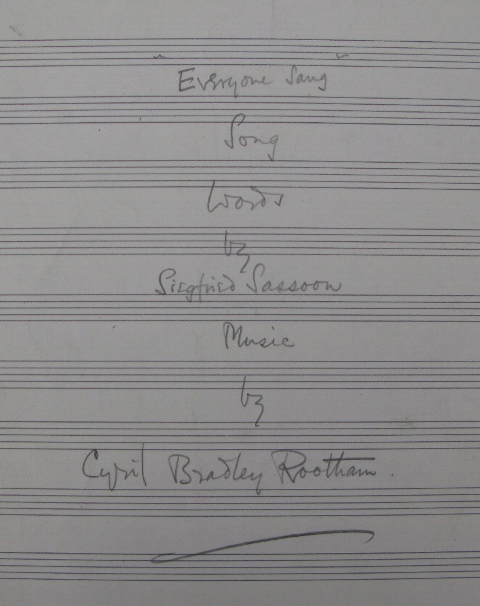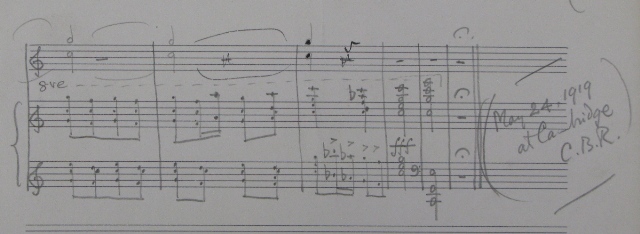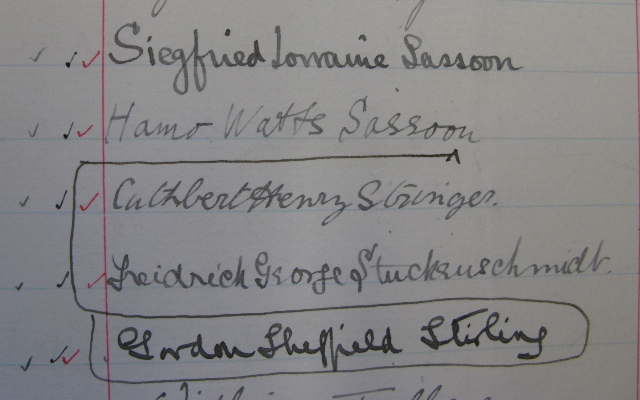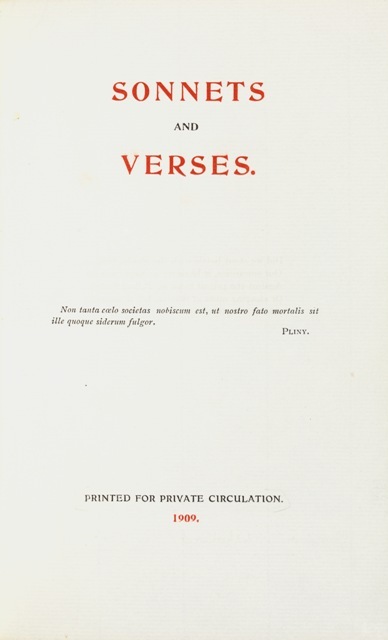It isn’t just the University Library which holds Sassoon material in Cambridge: two of the constituent colleges of the University, King’s and St John’s, do too, as the second link in Zoe’s ‘Outline online’ post below demonstrates. The ‘Autograph letters and poems of Siegfried Sassoon’ held in St John’s with the reference ‘Miscellaneous Papers SA4’ are of particular interest to us here in the UL, since they directly complement documents in our MS Add. 9192, a set of autograph scores by the composer Cyril Bradley Rootham (1875–1938), transferred from the Pendlebury Library of Music in 1993. Rootham was appointed Organist at St John’s College in 1901 and made a Fellow in 1914, retaining these posts until his death.
Most of the letters and poems in SA4 were sent by Sassoon to Rootham shortly after the end of the First World War. The two men met in Cambridge in January 1919 while Sassoon was on a visit to William Rivers, his mentor at the Craiglockhart War Hospital hospital in 1917, who was a Fellow of St John’s. Although neglected nowadays, in his time Rootham was a leading figure in the musical life of the University, and a respected composer, principally of choral works and songs. The relationship between poet and musician has been largely passed over by Sassoon’s biographers, but entries in Sassoon’s published diaries show that he attended a performance of Rootham’s opera The Two Sisters in Cambridge in February 1922, and in June that year Rootham arranged the music for Rivers’s funeral in the chapel of St John’s, at which Sassoon was present.
Short lyrics of the kind written by Sassoon lent themselves to the English song tradition and, after their introduction by Rivers, he and Rootham proceeded to co-operate on settings of a number of poems. The finding aid to the St John’s collection (http://janus.lib.cam.ac.uk/db/node.xsp?id=EAD%2FGBR%2F0275%2FMiscellaneous%2FSA4) indicates that Sassoon sent Rootham autograph and typescript versions of several of the poems from Picture Show, his privately printed volume which appeared in the summer of 1919, and of these, three are represented by scores in MS Add. 9192: ‘Butterflies’, ‘Idyll’ and ‘Everyone Sang’.

Cover sheet of Rootham's setting of 'Everyone Sang'. MS Add. 9192.95(7)
A score of the last of these, MS Add. 9192.95(7), was dated ‘May 24, 1919 at Cambridge’, so Rootham had set the poem before its first publication.

The last staves of Rootham's setting of 'Everyone Sang'. MS Add. 9192.95(7)
The Picture Show settings were published as Three Song-Pictures by Siegfried Sassoon, set to music by Cyril Bradley Rootham by West’s of London in 1920. Four further Sassoon poems set by Rootham were published by Curwen in the following year: ‘A Child’s Prayer’, ‘Morning Glory’, ‘A Poplar and the Moon’ and ‘South Wind’. Of these, there are scores for ‘Morning Glory’ and ‘South Wind’ in MS Add. 9192. In a diary entry for 11 March 1921 Sassoon recorded receiving copies of the settings of ‘A Child’s Prayer’ and ‘South Wind’, which, he wrote, ‘pleased me; so the day ended fairly well’. All seven songs were republished by Stainer & Bell in 1990, edited by Kenneth Shenton, who in his Introduction said of them that ‘though contrasted in mood, [they] offer many characteristics of Rootham’s mature style. Within his music there is a deep lyrical trait which is allied to a dynamic energy, so typical of the man. Typical also is the imagery in which natural life and physical elements are transmuted into a directness which evokes the essence of the human mood. Such imagery is much in evidence in these lovely settings.’
Rootham seems not to have published any settings of Sassoon after 1921, but he worked on four further poems in 1926: ‘Before Day’, ‘Morning-Land’, ‘Noah’ and ‘Tree and Sky’. Manuscripts of these scores are also found in MS Add. 9192. In another manuscript transferred to the UL from the Pendlebury Library, MS Add. 9105, there are holograph sketches by Rootham of settings of two poems from the sequence The Heart’s Journey (‘While I seek you, far away…’ and ‘I cannot pray with my head…’), although as Rootham acknowledged in a list of contents, these amount to a ‘few notes only’. The sketches are undated, but the inclusion of ‘I cannot pray with my head…’ suggests the texts may have been taken from the first ‘ordinary’ edition of The Heart’s Journey, which appeared in 1928, and not the limited edition of the previous year, which omitted the poem.
‘Music is a thing I can’t do without for long!’, Sassoon told another Cambridge musician, Edward Dent, in a letter of 1915. The manuscripts in St John’s Miscellaneous Papers SA4 and the UL’s MS Add. 9192 cast an interesting light on a brief but fruitful artistic collaboration.




